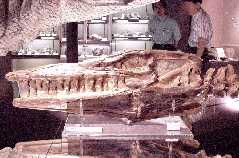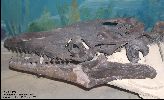Click on the Thumbnail |
Specimen Description |
Specimen Number / I.D. |
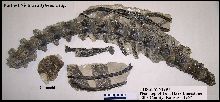 |
This string of vertebrae was collected in 1967 from the Fort Hays
Limestone in Ellis County, KS by M.V. Walker and was identified as Tylosaurus sp.
by Everhart (2005). It is the oldest example of Tylosaurus known (Lower
Coniacian) from Kansas and the only mosasaur remains ever collected from the Fort Hays
Limestone. |
FHSM VP-2297 - Fort Hays State University, Sternberg Museum of
Natural History. |
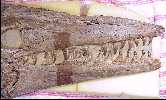 |
The most interesting thing about this Tylosaurus skull (HMG-1288)
from Logan County is the pathology shown on the right side. A large area of damaged
bone was visible on the right side of premaxilla and a fracture was evident in the suture
between the premaxilla and right maxilla. The unusual 'humped' silhouette of the
skull may indicate additional fractures. |
Hobetsu Museum,
Japan |
 |
This picture shows the extent of the damage to the skull (HMG-1288),
including the rearward displacement of the first tooth in the right maxilla. |
Hobetsu Museum,
Japan |
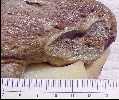 |
The damage on the premaxilla (and the fractures) appears to have
been caused by an impact with something very hard and solid, like a rock(?). This picture
shows that some healing had taken place before the mosasaur died. |
(HMG-1288)
- Hobetsu Museum, Japan |
 |
Tylosaurus proriger as exhibited on the south wall of the
Sternberg Memorial Museum in 1992. This specimen is about 10 meters (30 feet) in
length. See the same display at the new Sternberg Museum here.
(LARGE FILE) |
Sternberg Museum VP-3 |
 |
Tylosaurus proriger, dorsal and left lateral view of skull.
NEW 2/2000 - For close-ups of the skull, click on the following: Premaxilla, anterior upper
and lower jaws, left post orbital frontal, left jugal, and left
quadrate. A new picture of the skull is located HERE. |
Sternberg Museum VP-3 |
 |
Tylosaurus proriger, dorsal and left lateral view of skull,
different angle. In 1930, George F. Sternberg wrote regarding this specimen,
"Recently I mounted a skeleton, now on the walls of the Kansas State Teachers College
[Fort Hays State University] at Hays, which is thirty and one-half feet long. It has a
skull four feet long. Four paddles helped propel his powerful body through the water. It
was carnivorous, living on the flesh of many animals which inhabited these same waters.
This is not the largest mosasaur known, nor is it the smallest." |
Sternberg Museum VP-3 |
 |
Tylosaurus proriger, dorsal and left lateral view of muzzle
and lower jaws. The extended premaxilla shows up well in this picture. |
Sternberg Museum VP-3 |
 |
Tylosaurus proriger, dorsal and left lateral view of the
back half of the skull |
Sternberg Museum VP-3 |
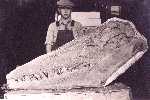 |
This picture shows the same specimen about 1926, relatively soon
after it was found. It is still in the plaster and burlap jacket that had been placed on
it in the field. George F. Sternberg provided the photograph when he offered the specimen
to Charles Gilmore at the Smithsonian Institution (USNM). Gilmore declined, citing
another specimen obtained earlier from Charles Sternberg. |
Photo collection of the USNM. |
 |
The left quadrate of VP-3, in position between the squamosal (top)
and the lower jaw (lower). |
Sternberg Museum VP-3 |
 |
Tylosaurus proriger; view of ribs and left front
paddle. Mosasaur limbs were greatly shortened and modified into paddles. |
Sternberg Museum VP-3 |
 |
The tip of the tail (caudal vertebrae) of the VP-3 Tylosaurus
proriger. |
Sternberg Museum VP-3 |
 |
Tylosaurus nepaeolicus, dorsal view of muzzle unit. NEW
2/2000 - For close-ups of the skull, click on the following: frontal; pterygoids;
maxillas; right
maxilla; premaxilla (1), (2), (3) and (4); quadrate; and teeth. |
Sternberg Museum VP-7262 |
 |
A Tylosaurus nepaeolicus partial skull w/quadrate from a
very large and fairly complete specimen. Note the extension of the premaxilla over
the front teeth. It was originally collected in 1984 by the Sternberg Museum and I found
additional pieces of the skull in 1990. Click here for a recent
(2002) publication on this specimen. |
Sternberg Museum VP-7262 |
 |
Tylosaurus nepaeolicus lower jaws. NEW 2/2000 - For a
close-up of the frontal and parietal, Click HERE. Click here for a recent (2002) publication on this specimen. |
Sternberg Museum
VP-2209 |
 |
A picture of a Tylosaurus specimen in the Tübingen
Museum in Germany. Collected by Charles Sternberg from the Smoky Hill Chalk
Formation. |
Natural History Museum, University of Tübingen. From
von Huene, 1919. |
 |
Tylosaurus proriger, lateral view of left side of skull
(approximately six feet in length), (Bunker Mosasaur, Pierre Shale, Kansas). This
specimen is featured on the Bunker Mosasaur webpage. |
KUVP 5033, The University of Kansas, Museum of Natural History |
 |
Tylosaurus proriger, lateral view of left side of skull and
upper body, (Bunker Mosasaur, Pierre Shale, Kansas). This specimen is featured on
the Bunker Mosasaur webpage, and is one of the largest
tylosaurs ever found (KUVP 5033). |
The University of Kansas, Museum of Natural History |
 |
Tylosaurus proriger, partial dentarys and a vertebra. NEW
2/2000 - For close-ups of this specimen, click on the following: Dentarys, teeth (1)
and teeth (2). Click
here for the vertebrae of another large Tylosaurus (VP-642) |
Sternberg Museum
VP-2496 |
 |
Tylosaurus proriger, root of 6th tooth of right dentary
compared to man's fist. This jaw came from a very large mosasaur, similar in size to
the Bunker Mosasaur shown above (Pierre Shale; Campanian). |
Sternberg Museum VP-2496 |
 |
Tylosaurus proriger, dorsal and left lateral view of
skull. This specimen represents the earliest documented record of this species
(early Santonian). This specimen is featured on the Tylosaurus webpage.
The skull is 1.2 meters (4 feet) long. |
Fick Fossil and
History Museum, Oakley, KS |
 |
Tylosaurus proriger, sclerotic ring from left eye. This
specimen is featured on the Tylosaurus webpage |
Fick Fossil and History Museum, Oakley, KS |
 |
Tylosaurus proriger, close up of left side of skull and
lower jaw. This specimen is featured on the Tylosaurus webpage |
Fick Fossil and History Museum, Oakley, KS |
 |
Tylosaurus proriger, muzzle and anterior portion of left
lower jaw. This specimen is featured on the Tylosaurus webpage |
Fick Fossil and History Museum, Oakley, KS |
 |
Tylosaurus proriger, dorsal view of frontal /parietal
suture. This specimen is featured on the Tylosaurus webpage |
Fick Fossil and History Museum, Oakley, KS |
 |
Tylosaurus proriger, lateral view of left quadrate with
preserved soft tissue. This specimen is featured on the Tylosaurus
webpage |
Fick Fossil and
History Museum, Oakley, KS |
 |
The snout (premaxilla and both maxillas of a large (10 meter) Tylosaurus
proriger from the Cody formation of eastern Wyoming (late Campanian?). This
formation is comparable to the Pierre Shale of western Kansas. |
Exhibited in the Tate Geological Museum, Casper,
WY |
 |
Tylosaurus proriger, dorsal and left lateral view of skull |
The University of Kansas, Museum of Natural History |
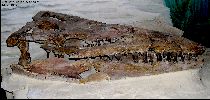 |
A very large Tylosaur proriger specimen from the upper
Smoky Hill Chalk of Logan County, collected by Judge E.P. West. Originally this
specimen was identified as Tylosaurus dyspelor. |
The University of Kansas, Museum of Natural History, KUVP 1032. |
 |
Tylosaurus sp., rostrum, partial denatures and maxillaries |
Sternberg Museum
VP-6907 |
 |
Tylosaurus kansasensis., dorsal and right lateral view of
skull |
Sternberg Museum VP-78 |
 |
Tylosaurus sp., Note: The left quadrate is displayed on
right side of skull in this mounted specimen. |
Sternberg Museum VP-78 |
 |
Tylosaurus kansasensis., dorsal and right lateral view of
skull (different lighting) |
Sternberg Museum VP-78 |
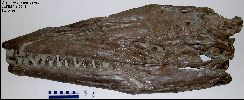 |
The holotype specimen of Tylosaurus kansasensis Everhart
2005, dorsal and left lateral view. For another view of the skull, click HERE. The
shorter premaxilla is a characteristic that seperartes T. kansasensis from T.
nepaeolica and T. proriger. Here
is a view of the skull as found with the cervical vertebrae at an odd angle to the skull.
This may indicate a broken neck or other injury that occurred at the time of death. |
Sternberg Museum
VP-2295 |
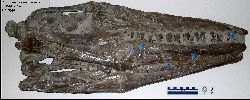 |
Tylosaurus kansasensis., ventral and right lateral view.
The lack of an infrastapedial process on the quadrates of T. kansasensis is
another feature that distinguishes them from the other Tylosaurus species. For a view of the right quadrate, go HERE.
The skull is about 70 cm in length and came from an animal that was about 5.6 m in
length (18 feet long). |
Sternberg Museum VP-2295 |
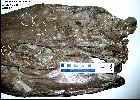 |
Tylosaurus kansasensis; Note the two deep bite marks on
frontal. The bites are probably from another, larger Tylosaurus. |
Sternberg Museum VP-2295 |
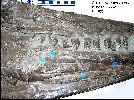 |
Tylosaurus kansasensis; note the large bite marks on right
dentary (marked with blue triangles). It is likely that this mosasaur died from a bite
that crushed the skull. |
Sternberg Museum VP-2295 |
 |
Tylosaurus sp., muzzle unit, dentarys and right quadrate |
Sternberg Museum VP-3366 |
 |
Tylosaurus sp., right quadrate and rostrum |
Sternberg Museum VP-3366 |
 |
The cast of a skull of Tylosaurus n. sp. in a private
collection. Part of a very complete set of remains, included preserved
cartilage from the Smoky Hill Chalk of Kansas. (UCB 138626). Collected by H.
T. Martin in 1927. |
The University of California Museum of Paleontology at
Berkeley |
 |
Tylosaurus sp., dorsal view of disarticulated skull.
This specimen is featured on the new species of Tylosaur page. |
Private Collection |
 |
Part of a huge Tylosaurus skull recovered from the Pierre
Shale of South Dakota. This specimen may, in fact, be a later and related species
called Hainosaurus. |
The Museum of Geology at the South Dakota
School of Mines and Technology |
 |
This is a scan of a photograph of preserved scales associated with
a Tylosaurus proriger specimen. It was published by S.W. Williston in
Volume IV of the University Geological Survey of Kansas (1898). |
The University of Kansas, Museum of Natural History |

